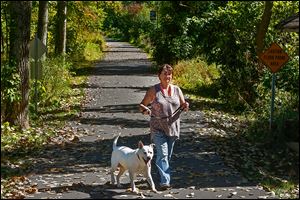
Sylvania renews discussion of River Trail on hospital land
Flower fears path near campus would disturb patients
9/30/2013
Chris Bowes of Ottawa Lake walks her dog Artie along the River Trail in Harroun Park in Sylvania. The first phase of the trail was finished last year, and officials are discussing its path across hospital land.
Sylvania officials’ review of site plans for a proposed rehabilitation center on the Flower Hospital campus has prompted renewed discussion about a future phase of the Sylvania River Trail, which would cross hospital land.
A campus master plan submitted this month to the city showing a site for the rehabilitation center, to be developed jointly by HCR ManorCare and ProMedica, Flower’s owner, also shows markings where the trail would cross campus boundaries. But it does not indicate a path between those points.
A first phase of the trail completed last year runs along Ten Mile Creek between Main Street and Harroun Road. Two phases would extend the trail west to Silica Drive and, more importantly to Flower Hospital, east from Harroun across hospital property near the Ottawa River and on to Monroe Street east of U.S. 23.
A conceptual plan prepared for the city four years ago by SmithGroup JJR of Ann Arbor, shows the trail south of the river, close to campus buildings — a route hospital officials say could invade the privacy of hospice-care patients and their families.
“Our main concern from day one is that we work collaboratively with the city to balance their vision, with a mutually compatible location that protects our patients and families,” said Alan Sattler, Flower’s president. “We looked at a number of locations, and some were close to our hospice center. We want to be thoughtful to those patients.”
The city prefers an upland route, because building the trail in the floodplain could nearly double the east-end phase’s $1.2 million construction cost estimate as well as the design costs, now budgeted at $300,000.
“As you get into the floodplain, you have to elevate the walkway, and build piers along the way, which is more expensive than putting down asphalt or concrete,” said Kevin Aller, the city’s service director.
One of the paths Flower favors would push the path north onto the floodplain, he said.
Also complicating the trail project is the expiration of easements the city obtained across other private land. Some will need to be renegotiated, Mr. Aller said.
Mr. Sattler said Flower is willing to donate land for the trail across its property and to share in re-design costs for that part of the route.
Councilman Mark Luetke said there is a high interest among some council members to move the project forward. Although there is no completion date set, there are state grant funds available in 2014, he said. Applying for the grants requires specific plans, he said.